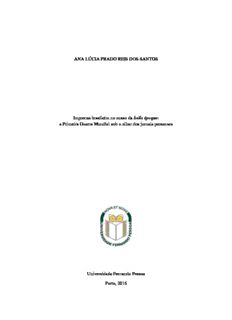
ANA LÚCIA PRADO REIS DOS SANTOS Imprensa brasileira no ocaso da belle époque PDF
Preview ANA LÚCIA PRADO REIS DOS SANTOS Imprensa brasileira no ocaso da belle époque
ANA LÚCIA PRADO REIS DOS SANTOS Imprensa brasileira no ocaso da belle époque: a Primeira Guerra Mundial sob o olhar dos jornais paraenses Universidade Fernando Pessoa Porto, 2016 Ana Lúcia Prado Reis dos Santos Imprensa brasileira no ocaso da belle époque: a Primeira Guerra Mundial sob o olhar dos jornais paraenses . Universidade Fernando Pessoa Porto, 2016 © 2016 Ana Lúcia Prado Reis dos Santos “TODOS OS DIREITOS RESERVADOS” Ana Lúcia Prado Reis dos Santos Imprensa brasileira no ocaso da belle époque: a Primeira Guerra Mundial sob o olhar dos jornais paraenses Tese apresentada à Universidade Fernando Pessoa como parte dos requisitos para obtenção do grau de doutora em Ciência da Informação, Especialidade em Jornalismo e Estudos Mediáticos, sob a orientação do Prof. Doutor Jorge Pedro Sousa. IMPRENSA BRASILEIRA NO OCASO DA BELLE ÉPOQUE: A PRIMEIRA GUERRA MUNDIAL SOB O OLHAR DOS JORNAIS PARAENSES RESUMO ANA LÚCIA PRADO REIS DOS SANTOS: Imprensa brasileira no ocaso da belle époque: a Primeira Guerra Mundial sob o olhar dos jornais paraenses. (Sob orientação do Prof. Doutor Jorge Pedro Sousa) A Grande Guerra foi o acontecimento ápice de tensões acumuladas entre as potências da Europa ainda no começo da segunda década do século XX. O conflito deflagrado no verão de 1914 expandiu-se e envolveu nações de outros continentes, tornando-o mundial, com repercussões que extrapolaram os mais de quatro anos de batalhas oficiais – atualmente pode-se concluir que a Segunda Guerra Mundial nada mais foi do que a segunda parte de um conflito que não acabou de forma a contentar todos os países beligerantes. Entretanto, a Grande Guerra também demarcou o final de uma era conhecida como belle époque, um tempo que simbolicamente representava o apogeu cultural, econômico e social na Europa, inspirador do modelo civilizador em nações no novo mundo, inclusive no Brasil. Na Amazônia, sobretudo na capital do Estado do Pará, Belém, vivia-se ainda sob o imaginário da era da abundância provocada pela exportação da borracha nativa, cujo inicio ocorreu no final do século XIX e na primeira década do século passado. Nesse cenário, desenvolveu-se um jornalismo forte e muito sintonizado com as questões nacionais, regionais e de além-mar. Formado por intelectuais, políticos e escritores, o jornalismo paraense cobriu de forma sistemática os acontecimentos em torno da Grande Guerra, desde a morte do herdeiro do trono do Império Austro-húngaro, Francisco Ferdinando, até a paz ser selada. Com base neste panorâma, o objetivo desta investigação centra-se no esforço para compreender a natureza da cobertura jornalística dos jornais paraenses acerca da Primeira Guerra Mundial, tendo como objeto de análise três jornais diários que circulavam à época: Estado do Pará, Folha do Norte e A Tarde. Os dois primeiros eram jornais generalistas e de longo período de circulação. O terceiro foi um jornal vespertino, publicado entre setembro de 1915 e setembro de 1916, portanto, de caráter ocasional. Para alcançar esse objetivo, a metodologia usada compreende as análises quantitativa e qualitativa de conteúdo, conforme descrito por Sousa (2006). A primeira parte das XI IMPRENSA BRASILEIRA NO OCASO DA BELLE ÉPOQUE: A PRIMEIRA GUERRA MUNDIAL SOB O OLHAR DOS JORNAIS PARAENSES análises centra-se em avaliar os dados relativos ao número de peças, de espaços dedicados ao tema da guerra, entre outros aspectos quantificáveis. Na segunda parte usou-se a análise qualitativa com base no estudo do diálogo establecido entre os aspectos da historiografia e os achados jornalísticos nos três jornais. XII IMPRENSA BRASILEIRA NO OCASO DA BELLE ÉPOQUE: A PRIMEIRA GUERRA MUNDIAL SOB O OLHAR DOS JORNAIS PARAENSES ABSTRACT ANA LÚCIA PRADO REIS DOS SANTOS: Brazilian press in the decline of the belle époque: The First World War under the look of parense newspapers (Under the orientation of Prof. Dr. Jorge Pedro Sousa) The Great War was the event that motivated the outburst of the tensions accumulated between the strongest European nations, at the beginning of the second decade of the twentieth century. The conflict was triggered in the summer of 1914 and involved nations from other continents, turning it into a worldwide problem, with repercussions that went beyond the more than four years of battles. After all, World War II was nothing more than the second part of a conflict that didn`t finish in order to settle all the belligerent countries. However, the Great War also marked the end of an era known as thebelle époque, a time that symbolically represented the cultural, social and economic heyday in Europe, inspiring the civilizing model nations in the new world, including Brazil. In the Amazon, especially in the capital of the state of Para, Belem, people still lived in the imaginary of the age of abundance, promoted by the export of native rubber, that began in the late nineteenth century and the first decade of the last century. In this scenario, it was developed a strong sense of journalism, attuned to national, regional and overseas issues. Formed by intellectuals, politicians and writers, the journalism in Para covered systematically the events surrounding the Great War, since the death of the heir to the throne of the Austro-Hungarian Empire, Franz Ferdinand, until the moment peace was sealed. Based on this overview, the objective of this research focuses on the effort tounderstand the nature of media coverage of Para newspapers about the First World War, with the main purpose of analysing three daily newspapers that circulated at the time: Estado do Pará (Para State), Folha do Norte (Northern Paper) and A Tarde (The Afternoon). The first two were general and long circulation newspapers. The third was an afternoon paper, published between September 1915 and September 1916, therefore, it had an occasional character. To achieve the goal, the methodology used included quantitative and qualitative content analysis, as described by Sousa(2006). The first part of the analysis focuses on evaluating XIII
Description: